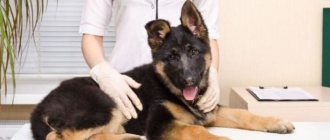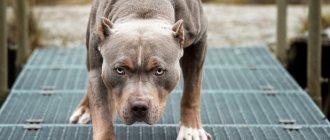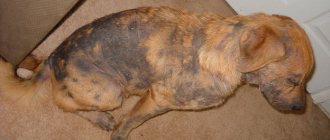In veterinary practice, a dog limping on its front leg is a common problem. In animals with this pathology, the gait changes and asymmetry of movement appears. This condition occurs as a result of various pathologies and injuries. The animal, trying to avoid pain, changes its body position and begins to limp. In this case, the owner usually asks the question: when the dog twists its paw and is limping, what to do. It is necessary to show your pet to a specialist to determine the cause of the problem and prevent serious complications.
What is lameness
Lameness is usually called a violation of the step. The animal redistributes its body weight, trying not to step on the painful limb. During rest, the puppy presses the sore limb.
A dog can limp for a variety of reasons.
Detection of lameness
Lameness is fairly easy to spot. If the front paw hurts while moving the load on it, the animal's head and neck will move upward. A characteristic change in the dog’s gait allows the owner to quickly understand that something is happening to his four-legged friend. The dog starts jumping instead of walking.
If the hind limb is damaged, there is a downward collapse of the pelvis. Sometimes the problem is symmetrical, affecting the right or left side. In this case, the front and back paws are affected on one or the other side.
Important! Diagnosis of lameness should be carried out by a specialist to exclude dangerous pathologies.
Symptoms
The problem can be identified by the following symptoms:
- inability to put weight on the affected leg;
- pain at rest and when walking;
- the animal cannot stand on a limb from a lying position.
When the pain is severe, the dog whines and licks its paw.
Examination by a veterinarian
Detection of lameness
Determining whether your dog is limping and what the nature of the deviation from the norm is is not always easy. You need to evaluate the dog's movements from all sides and at different steps. The time of observation is also important, because even slight dragging of the hind paw after sleep should be a signal to take action.
Measuring your stride length may be a convenient technique. To do this, let your four-legged friend walk on wet ground while walking so that his paw prints are clearly visible. After this, measure the distance between the prints of each limb. The stride of the paw that is causing the pain will be shortened, and the print itself may be turned toe in or out.
Once you have determined whether your pet is limping, you need to contact your veterinarian. Only in this case is adequate treatment possible. It is worth abandoning traditional methods of treatment, as this can only worsen the animal’s condition.
Types of lameness in animals
The cat is limping on its front leg without visible damage
Lameness is usually classified depending on the provoking factor.
The following types of pathology are distinguished:
- Hanging limb. Pain appears when moving the paw. The provoking factor is muscle injury.
- Supporting limb. When an animal leans on a sore limb, pain occurs. The animal whines, trembles, and behaves restlessly.
- Mixed. Combines the previous two types. Occurs as a result of inflammatory processes in large joints.
Pain varies in intensity depending on the extent of damage to the limb.
How to determine a limb injury?
Often dogs get injured while walking, cutting themselves on glass. Thus, it is mainly their front paws that suffer, being the first to touch an object. They also take the main load during landing from jumps, so bones or joints are often damaged. It is possible to determine that a dog is limping on its front leg due to an injury through a careful examination. Burns and wounds always leave traces, you can find a red burnt area or a place of bleeding. You also need to examine the paw pads for a bruise or a broken claw at the root.
The examination must be carried out very carefully, since if there is a fracture, any touch can cause severe pain to the dog. There is no need to try to forcefully straighten or bend the joint in order to “help” the animal. Dogs have a very high pain threshold, and if they don’t want some place to be touched, then the discomfort is very strong. In case of a fracture, it is not necessary that the injury was received in the lower part of the paw. It could be much higher. An accurate diagnosis can be made by a veterinarian after X-rays and examination.
Degrees of lameness
The dog is limping on its hind leg with no visible damage.
Detection of lameness is a reason to assess the condition of the animal. If there are no apparent reasons, the dog should be tested in motion. Smooth, free and springy movements eliminate problems with the musculoskeletal system.
Pathology is divided into 3 degrees:
- First. The animal briefly steps on the paw, but tries to quickly step over.
- Second. The puppy practically does not step on the limb that it presses or carries forward.
- Third. The dog is unable to step on its paw or move it.
Diagnosis of lameness
What could be causing your pet to limp? Most common reasons
- Damage to feet and fingers. The most common causes of lameness are injuries to the foot and toes while walking. In this case, you can conduct the inspection yourself. Wounds, cuts, and abrasions to the paw pads, toes, and tissue between the toes can cause lameness. Such injuries are usually visible to the naked eye. If, after examining your feet and toes, you find something similar, simply treat the injured areas with hydrogen peroxide.
- Splinter. A dog may also get a splinter on its paw. Having got deep under the skin and into soft tissues, the splinter causes severe pain in the animal and, as a result, lameness. Remove the splinter with tweezers. You will also need a cotton swab moistened with an alcohol solution, which is used to pre-lubricate the skin. If the splinter is very deep and cannot be caught with tweezers, you should consult a veterinarian.
- Insect bites. Short-term lameness can be caused by the bites of a bee, snake, tarantula, in short, any poisonous insect or reptile. Painful inflammation and swelling occurs at the site of the bite. It is recommended to treat the bite area with a soda solution (a mixture of water and soda in a ratio of 10 to 1). When stung by a bee, garlic juice is also effective, which can be squeezed out with a regular garlic press and applied to the stung area. After this, try offering your dog sweet tea. If you are bitten by a snake, tarantula, or have a severe allergic reaction to bee venom, you should immediately consult a doctor.
- Ticks. In the spring-summer season, your pet may be attacked by a tick. If it sticks to the foot, it will not only cause discomfort, but can also become a source of dangerous diseases, such as encephalitis. ?
- Dislocation or sprain. Lameness can also be associated with a dislocation, sprain, or bruise of a joint. The symptoms of such injuries are approximately the same - the dog stops stepping on the paw, the dislocated joint may be deformed, there is pain when palpated, and the dog whines due to pain. It is better not to correct a dislocation on your own, as this can cause even more serious injury to your pet. If you suspect your dog has a sprain, try gently securing the joint with a tight cloth or bandage. You can apply ice on top, as you would with a bruise, to reduce the pain. After this, you should definitely consult a doctor, since a sprain or dislocation will not go away on its own, and over time will lead to an even more pronounced lameness.
- Fracture. In this situation, most likely, the dog will not be able to step on the injured limb at all. Any touch to it will cause severe pain. If there is a fracture, you will not be able to help your pet on your own. If you leave everything as it is and neglect medical help, you can end up with the bone healing incorrectly and the dog limping and experiencing discomfort for the rest of its life.
It is more difficult to determine the reasons why a dog is limping on its front leg if there are no visible injuries.
Possible reasons
The cat is limping on its hind leg with no visible damage.
Lameness can be congenital or acquired. In the first case, the pathology develops as a result of abnormal intrauterine development. Newborn puppies have congenital joint pathologies, underdevelopment of ligaments, and one shortened limb. In the second case, lameness manifests itself as a concomitant symptom of various diseases.
Additional Information! Correctly identifying the cause of the problem will allow you to effectively eliminate it.
Minor damage to the paw
The dog begins to twist its paw and limp even with minor dislocations or bruises. A dog can bruise or damage its paw during walks and training. But what to do if the dog twists its paw and is limping?
Minor injuries do not require special treatment. The pet should be allowed to lie down for two days until the wounds heal a little. But there are injuries (rupture, sprain) that require professional help.
Paw injury
A bite of an insect
It is quite rare. But the bite can cause lameness. This problem is typical during the spring-summer period, when mosquitoes or wasps appear. Redness and swelling appear at the site of the bite. Animals with allergies may develop complications, so they should be given antihistamines immediately.
Important! In some regions, animals are susceptible to snake bites. In the absence of emergency assistance, the animal may die.
For therapy, veterinarians use injections and droppers of antidote. Ticks and tarantulas are very dangerous for dogs.
Rheumatoid arthritis
Dogs, like people, can develop pathologies of bones, muscles and joints. Among the most common diseases is rheumatoid arthritis. Arthritis affects the cartilage tissue of the joints in pets of medium and large breeds. The cause of the disease is poor nutrition, excessive physical activity, and old injuries.
Rheumatoid arthritis in a dog
Joint dislocations and muscle strains
A common occurrence for active and active dogs who like to run or dig a hole. They can strain a muscle, bend a paw, or dislocate a joint even while walking. With the correct actions of the owner, the problem can be quickly eliminated. The dislocated joint is fixed with a tight bandage and shown to a specialist.
Tumors in the area between the fingers
Neoplasms on the extremities become a significant problem for normal movement. Hair on the paws complicates diagnosis. The owners discover the tumor at a late stage. When the formation becomes large enough, it causes discomfort to the dog.
Over time, the lump turns into an ulcer, which can crack the skin and ooze blood. Self-medication is strictly prohibited. The veterinarian must diagnose and take action to correct the problem.
Autoimmune idiopathic polymyositis
This disease is a diffuse inflammation of a group of skeletal muscles. As the disease progresses, destruction of muscle fibers occurs. The pathology can develop in any middle-aged breed. Depending on the course, there is an acute or chronic form.
Animals experience general weakness and decreased reflexes. With timely treatment, complete restoration of muscle function is possible.
Important! Periodic examination by a specialist will help identify the disease at an early stage.
Hereditary pathologies
Many canine diseases are hereditary and cannot be cured. One of the most unpleasant pathologies in which an animal can become lame is a degenerative change in the structure of the joint. In most cases, this disease affects the hind limbs. The progression of the disease can lead to joint destruction.
In this case, surgical treatment is most often used. An implant is installed to maintain joint mobility.
Consequences of injection and other manipulations
One of the common causes of pathology in an animal is an injection or other veterinary manipulation. Painful sensations appear due to the rapid or, conversely, slow administration of the medicine, as well as the inept actions of the doctor.
Installation of a catheter also causes inconvenience. Even after its removal, the dog may habitually limp for some time. If the cause is nerve damage, then neuralgic treatment using massage and medications will be required.
Thorn in the paw
Dogs can pick up splinters in the alleys. A foreign body can get into the bend of a limb, muscle, or into the pad of the paws. The splinter causes discomfort to the dog. If it is not removed, suppuration may begin. Therefore, you need to immediately remove it and treat the injured paw.
Cyst between fingers
A problem typical for short-haired dogs. The cause of the disease is considered to be injuries to the hair follicles, sebaceous glands, subcutaneous tissue resulting from parasitic, chemical, mechanical, infectious or parasitic exposure. There is redness and swelling on the outside of the paw.
Cyst on paw
Fracture
The animal cannot step on the limb with a fracture, and the slightest touch to it causes sharp and severe pain. The dog must be urgently transported to a veterinarian, where he will receive qualified assistance under anesthesia.
Arthritis
The disease is an inflammation of the joint. Characteristic symptoms:
- edema,
- pain,
- increase in local temperature,
- the animal begins to limp.
Pathology develops due to injury, infection or autoimmune processes. Predisposing factors are joint injuries and heavy weight. There are many varieties of the disease. It appears gradually, starting with a slight limp and gradually leading to loss of mobility of the affected limb.
Important! The disease can be successfully treated with special exercises, diet and medications.
Arthrosis
Lameness in dogs in 80% of cases occurs due to arthrosis of the large joints of the limbs. The disease occurs in older animals, rarely in young ones. According to statistics, males get sick more often than females. This is due to the large weight of the animal.
The disease is incurable. With the help of specialists, you can slow down the development of pathology and alleviate the animal’s condition.
Prevention
- During a walk, you need to make sure that the dog does not run into areas where glass, brick fragments, or sharp metal objects may be scattered.
- If several animals are playing together, it is better to ensure that the larger ones do not “chase” the smaller ones - at such moments, pets often receive dislocations and bruises.
- Adhere to a nutritious and nutritious diet with the addition of vitamin complexes for the healthy development of bones, muscles and joints.
- When receiving a puppy, you should inquire about the health of the parents. Some hereditary diseases may never appear with proper care.
- Maintain adequate physical activity for age, condition and breed. So, dogs of small breeds should not jump down from too high a height - landing on their front paws, they can damage them. A number of large breeds and older animals have difficulty using stairs; you need to spare your pet.
Lameness of the front legs in dogs can indicate not only a banal injury, but also certain diseases. The animal’s health can be improved with the help of veterinarians, but with a number of diagnoses, complete recovery, unfortunately, is impossible.
Sudden lameness.
Typically due to some form of traumatic injury. This can range from simple and usually obvious causes such as: cuts, wounds, foreign bodies (eg glass, nails, grass) entering the ball of the foot, to more insidious conditions such as torn ligaments, fractures. If a dog licks its paws excessively and is limping, a cut or foreign body may be suspected, but an infection called interdigital dermatitis may also be suspected. Fractures are also a common cause of lameness, usually due to some kind of injury, for example, car accidents. They can range from mild (but painful) where the bone is just cracked, to severe bone crushing.
Some owners notice an unusual form of lameness in their dogs. In this case, the dog may suddenly limp on one hind leg, dragging it behind him. And then suddenly the dog becomes normal again. This form of lameness is often caused by a luxated kneecap (patella luxation). Dislocation can occur in any breed, but is most common in small breeds (in them it is often inherited from their parents). When the kneecap moves out of its normal position, it acts like a wedge and tightens the ligaments around the knee so that the animal cannot bend the leg. Then suddenly the kneecap slides into place and the dog can walk normally again. Another condition in small dogs, especially young ones, that causes lameness is a condition known as Legg-Calvé-Perthes disease or necrosis of the femoral head. This problem is also inherited from parents. During this disease, the blood supply to the femoral neck fails, the neck disintegrates and destruction of the joint occurs. This further leads to severe lameness.
Types of dislocations in dogs
The dog's bones are connected to each other like hinges. This allows the paws to bend and move. The point of connection is the joint itself. Muscles and ligaments are connected to it. If 2 articular bones move, dislocation, subluxation, or sprain of ligaments will occur, which will complicate movement or make it impossible. Therefore, the bones need to be returned to their original position as soon as possible. This will prevent aggravation and more serious damage.
Dislocations are systematized according to several parameters:
- according to the statute of limitations - fresh, stale, outdated;
- by type - complete and incomplete;
- by origin - congenital and acquired;
- acquired ones are divided according to the method of appearance into traumatic and pathological;
- according to the characteristics of the injury - open and closed, complicated and uncomplicated, complete and incomplete.
Important! For pet dogs and puppies with limited activity, the serving size should be reduced by approximately 10%. If this is not done, the pet will gain excess weight during the injury.
Due to damage
Based on etiology (cause of damage), there are 2 groups of articular bone displacements:
- obtained in the prenatal period of development;
- happened during the pet's life.
Most often, pathology is the result of an injury: an unsuccessful jump, a fall, a collision with a moving object, the result of a dog fight. Such a dislocation in a dog is called traumatic.
But displacement can also occur during intrauterine development. For example, a pregnant female has been injured or there is a congenital pathology of the fetus itself. Such dislocations are called congenital. The pet will experience their consequences throughout its life.
Traumatic
Traumatic dislocations are very common and very diverse.
They arise due to indirect trauma:
- falling on an incorrectly bent limb;
- sudden muscle contraction (electrical injury);
- lever-like action of the applied force on the joint (ligament rupture).
Treatment for bone misalignment consists of 3 steps: joint reduction, short-term fixation, follow-up therapy.
Did you know? The smallest dog in the world, in terms of height, is a Chihuahua named Millie, who lives in Puerto Rico with her owner. Her height is only 9.65 cm. At birth, Millie weighed only 28 g and fit in a teaspoon.
Congenital
The cause of congenital dislocation is a violation of intrauterine development of the fetus. It manifests itself in the form of pathologies in the growth of articular tissues. The muscles could be underdeveloped and then it is noticeable that “the left front paw is longer than the right,” etc. The most common is hip dislocation. Treatment consists of using special orthopedic devices, therapeutic exercises and massage of the underdeveloped muscle to change its length.
Pathological
The cause of pathological dislocation is illness. As a result, the development of connective tissue slows down and the limb lags behind in growth. The joint appears loose, and the bones may bend at an unusual angle. Like congenital dislocation, it is treated through therapeutic exercises, massage, and orthopedic devices.
Paralytic
The displacement occurs due to paralysis of the muscles that “pulled” the joint, which is why the dislocation is called paralytic. Over time, the muscles will begin to atrophy and the limb will cease to function.
Unruly and familiar
If, after a previous dislocation, the ligaments are stretched and do not return to normal, then the likelihood of a repeat incident is high. This type of dislocation is called habitual. It can happen under normal conditions, without putting excessive strain on the joint. If another bone or tendon prevents the bone from being returned to its place, the dislocation will be called irreducible. To remove it, surgery will be required.
By timing of injury
Classification according to the age of the dislocation is not important for the patient, but is important for choosing a treatment method. To cure fresh (up to 3 days) and stale (up to 3 weeks) displacements, it is enough to set the joint in place. And an old dislocation (more than 1 month) is already complicated by improperly fused connective tissues and other pathologies. Therefore, it needs to be treated and restored in a completely different way.
For tissue damage
The division into open and closed affects the provision of first aid to the victim. In the open form, there are not only damaged tendons, but also an open wound. She needs to be treated with an antiseptic and ensure complete rest until assistance is provided at the veterinary clinic. A closed dislocation is one in which there is no external damage.
Answer
Good day. Feed the dog well, the diet is in order. Lameness is difficult to diagnose from a distance. Possible:
- sprain due to an unsuccessful jump;
- joint dislocation;
- fracture;
- a cut;
- cracked pads;
- hip dysplasia;
- arthritis, arthrosis.
Alabai (Central Asian Shepherd Dog) is a large and massive dog. A balanced diet and a vitamin complex are required, especially calcium to strengthen bones, and you should move a lot, avoiding obesity. During puppyhood, the dog breed is susceptible to diseases of the musculoskeletal system. The puppy quickly gains weight - at 3-4 months it weighs 20 kilograms or more, but the bones are not really strong. Hence the trouble. The weight is high, the paws are weak, an unsuccessful jump means a sprain or a more serious situation. Then refusal to eat, as a result of weakness in the paws, is a normal development of events.
Carefully examine the dog's paw and observe the reaction. Be careful - if the dog is in pain, it can bite. If you find that the paw is damaged, swollen, red, bleeding wounds or a fracture are visible, you will need to provide first aid to alleviate the animal’s condition. Then go to a veterinary clinic so that the doctor takes an x-ray, if necessary, takes tests, and prescribes a course of treatment. If no visible damage is found on the sore paw, and the animal is limping, you can’t hesitate, you need to urgently go to the veterinarian!
Lameness is a common condition in dogs. Appears due to mechanical damage, thermal damage, due to the genetic predisposition of the breed, inflammatory processes in the joints.
How to correctly determine the cause of lameness
Lameness may appear suddenly or worsen over time, or it may appear periodically.
A sudden change in gait is usually caused by an injury to the back or limbs. External disturbances in the shape of the body may not be observed, but they are noticeable from the dog’s movements.
For example, a dog was running and frolicking and suddenly began to whine, howl, limp, or stopped moving altogether. Most likely, the cause was injury to some part of the body.
It is unlikely to independently determine the exact cause of the pain. The dog needs to be shown to a veterinarian. At the veterinary clinic, your pet will be carefully examined, x-rayed, and treatment for the injury will be prescribed.
In case of periodic lameness, for example after sleep or long nailing in one position, specialists' suspicions fall primarily on arthritis or arthrosis.
If chromate is periodic and worsens over time, to determine the cause, the dog will have to undergo a comprehensive examination in a veterinary clinic.
The reason for this is internal degenerative changes in bone and cartilage tissues, pinched nerves and neoplasms. Without a veterinary examination, it will be impossible to identify the true cause.
Lameness is always associated with severe changes in the functioning of the musculoskeletal system.
It causes your pet a lot of problems, discomfort and pain. In the absence of timely treatment, the dog in most cases remains disabled.











